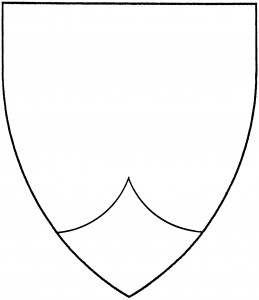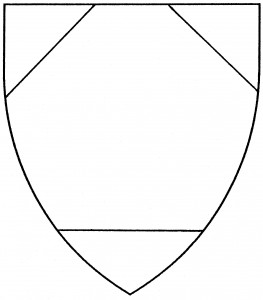A point is one of the corners of the shield. The unmodified term is synonymous with a base. The point is most often used in a modified form called a “point pointed”: a triangular shape issuant from base, extending roughly one-third the height of the shield. The sides are properly drawn with concave sides, but there is one period example with flat sides – the canting arms (Portuguese canto, “corner”) of Canto or Docanto, c.1540 [Nobreza xxxviiº] – so the concavity of the sides is left to the artist.
The “dexter” and “sinister” points are the upper corners of the shield. The dexter point was considered an abatement of honor by Legh, 1562; neither the dexter nor sinister point were actually used in period armory. For that reason, the use of either dexter or sinister point is not permitted in Society armory. The use of all three points, as in the illustration, was once permitted but is now disallowed, pending period examples.
The term “point”, when used to denote a specific spot inside the shield (e.g., “fess point”, “nombril point”, &c), is not a medieval usage and is no longer practiced in Society blazonry. See also mount.
Cuðbriht se breowere bears: Quarterly azure and gules, a point pointed Or.
Marian Greenleaf bears: Or, a point pointed flory counterflory gules.
Andrew Drexler bears: Sable, on a mullet of four points argent between three points Or, a fireball gules.

